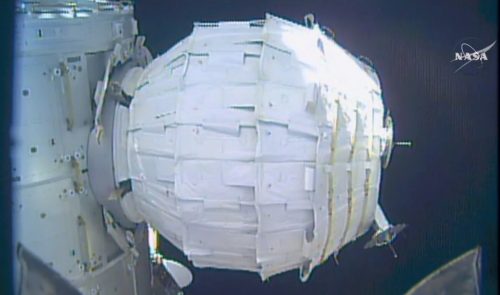BEAM, the first manned inflatable space vehicle in history, has successfully inflated after docking with the International Space Station in the folded configuration in which it was launched last month. The module will remain connected to the station for two years and will serve as a technological demonstrator to examine the usability and safety of inflatable vehicles in space.

The experimental Bigelow Expandable Activity Module or BEAM for short, built by the American company Bigelow Aerospace, Good luck blowing By NASA astronaut Jeff Williams on May 28. In about a week, after checking that there are no leaks from the module, the station's occupants will enter it for the first time.
After the successful inflation, the experimental module will remain attached to the space station for the next two years to test its various properties and its ability to keep the astronauts safe in the harsh environment of outer space. Bigelow Aerospace built it as a technology demonstrator for inflatable space stations it plans to build in the future.
BEAM, which was launched to the station by SpaceX's Dragon resupply spacecraft on April 8 this year, is the first inflatable space vehicle in history adapted for the stay of astronauts in space.
The first attempt to inflate the new addition to the space station was made on Thursday without success, after the module did not inflate enough in relation to the air pressure injected into it. NASA then decided to stop the experiment, remove the air pressure and try to re-inflate it later. According to NASA, one of the reasons for the failure of the first attempt is apparently the force of friction between the layers of fabric that make up the walls of the inflatable module.
The second attempt was made on Saturday and passed successfully. At the end of the inflation process, which was supervised by the American astronaut Jeff Williams who was standing outside the module at its connection point to the tranquility module of the space station, the module reached its full size with a length of 4 meters, a diameter of about 3.2 meters and a volume of 16 cubic meters.
Inflatable space vehicles can provide more volume relative to their weight, because they are not made of rigid and heavy metals like the other components of the International Space Station. In addition, since they are launched in a folded and compressed configuration and inflated only after launch, vehicles with a greater final volume can be launched compared to rigid vehicles.
The idea of building an inflatable module was originally developed by NASA in the 90s, but was eventually abandoned in favor of rigid space vehicles. Bigelow Aerospace, founded by tycoon Robert Bigelow in 1998, signed agreements with NASA that allowed it to develop the idea. About a decade ago, the company launched its first inflatable spaceships, Genesis 1 and Genesis 2, which, unlike BEAM, were unmanned and not connected to the space station.
Bigelow Aerospace plans to build more advanced inflatable space stations in the future. The model she is developing is called the B330, a name that refers to its volume - 330 cubic meters. With a planned weight of 20 tons, and compared to the Destiny module of the International Space Station which weighs 15 tons and contains only 160 m210, the future module provides an increase of about 33% in volume with only XNUMX% more weight.
Last month, after the successful launch of BEAM to the space station, Bigelow Aerospace and the American launch company ULA (which is jointly owned by Boeing and Lockheed Martin) Announce a joint agreement To launch a private inflatable space station in 2020 that will be based on the B330 design.
Robert Bigelow noted that one of the options being considered is to connect the future module to the International Space Station, which would increase its volume by 30%. In that case, the future module could be used both for scientific research and as a "space hotel" for space tourists.
Beagle too Offers use its inflatable module for manned missions in deep space, such as manned missions near the Moon or to Mars. According to Bigelow's proposal, the inflatable module would serve as the astronauts' residence during long-duration missions in space, because the Orion spacecraft, which NASA is currently developing, has a relatively limited volume and is unable to sustain the astronauts for a long time.
See more on the subject on the science website:

2 תגובות
that's for sure ?
It looks like an origami water bomb.
I wonder what this thing looks like on the inside and how durable it is.